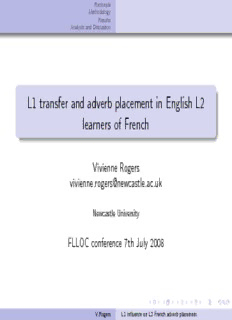
L1 transfer and adverb placement in English L2 learners of French PDF
Preview L1 transfer and adverb placement in English L2 learners of French
Rationale Methodology Results AnalysisandDiscussion L1 transfer and adverb placement in English L2 learners of French Vivienne Rogers [email protected] NewcastleUniversity FLLOC conference 7th July 2008 V.Rogers L1influenceonL2Frenchadverbplacement Rationale Methodology Results AnalysisandDiscussion Outline 1 Rationale Structure of French and English Research questions 2 Methodology Task Participants 3 Results 4 Analysis and Discussion V.Rogers L1influenceonL2Frenchadverbplacement Rationale Methodology StructureofFrenchandEnglish Results Researchquestions AnalysisandDiscussion Background Examine the role of the first language in the second language acquisition of French. Specifically looking at the acquisition of adverbs. Cross-sectionally at different points in development Part of the AHRC funded FLLOC project (ref. 112118) and this data will be made available on the website V.Rogers L1influenceonL2Frenchadverbplacement Rationale Methodology StructureofFrenchandEnglish Results Researchquestions AnalysisandDiscussion Simple adverb placement French and English differ in terms of adverb placement, e.g. Jean regarde souvent la t´el´e. *Jean souvent regarde la t´el´e. John often watches TV. *John watches often TV. According to Pollock (1989) this difference is due to verb raising, i.e. the adverbs are in the same place and the verb is in a different place. French has a strong uninterpretable Tense feature but English does not. Cinque (1999) argues that all adverbs are part of a universal hierarchy. V.Rogers L1influenceonL2Frenchadverbplacement Rationale Methodology StructureofFrenchandEnglish Results Researchquestions AnalysisandDiscussion Underlying phrase structure, Pollock 1989, Cinque 1999 English French. V.Rogers L1influenceonL2Frenchadverbplacement However, this sentence final position only appears to be allowed for certain adverbs and not others. *Jean regarde la t´el´e probablement. *John watches TV probably. Rationale Methodology StructureofFrenchandEnglish Results Researchquestions AnalysisandDiscussion Other adverb positions French and English also allow adverbs to appear in other unstressed positions. Jean regarde la t´el´e souvent. John watches TV often. V.Rogers L1influenceonL2Frenchadverbplacement Rationale Methodology StructureofFrenchandEnglish Results Researchquestions AnalysisandDiscussion Other adverb positions French and English also allow adverbs to appear in other unstressed positions. Jean regarde la t´el´e souvent. John watches TV often. However, this sentence final position only appears to be allowed for certain adverbs and not others. *Jean regarde la t´el´e probablement. *John watches TV probably. V.Rogers L1influenceonL2Frenchadverbplacement Rationale Methodology StructureofFrenchandEnglish Results Researchquestions AnalysisandDiscussion Laenzlinger account for sentence final adverbs Laenzlinger (2002, 2004) argues that Cinque’s universal hierarchy of 50+ projections can be grouped into 4: MoodP, ModP, AspP (high), AspP (low). He argues that only the AspP(high) adverbs permit sentence final adverbs. He suggests that this is a case of low-object scrambling. V.Rogers L1influenceonL2Frenchadverbplacement Rationale Methodology StructureofFrenchandEnglish Results Researchquestions AnalysisandDiscussion 1 Do L1 learners transfer their knowledge of English (i.e. do they not raise the verb over the adverb)? 2 If so, do they later adopt the French setting? 3 Do the L1 learners allow sentence final adverbs (object scrambling)? 4 If so, do they distinguish between the types of adverbs that allow object scrambling? V.Rogers L1influenceonL2Frenchadverbplacement Rationale Methodology Task Results Participants AnalysisandDiscussion Tasks Each student completed two tasks: 1 Pre-test measure of receptive vocabulary size 2 Oral production task administered as part of a larger task involving negation 15 obligatory contexts - 10 targeting adverbs only and 5 with both negation and adverbs each student completed the production task before the judgement task 3 Grammaticality judgement task 64 tokens on task: 24 relating to adverb placement. equally weighted between grammatical and ungrammatical targeted English adverb order (SAVX), standard French order (SVAX), sentence initial adverbs (ASVX) and sentence final adverbs (SVXA). students had to circle whether a sentence was very good/good/bad/very bad/ don’t know V.Rogers L1influenceonL2Frenchadverbplacement
Description: